Isabella Bradford's Blog, page 13
May 24, 2018
Friday Video: The Uniforms of the Household Cavalry
Susan reporting,
Since the post earlier this week featuring the frock coat worn by the newly married and newly minted Duke of Sussex was so popular, I thought I'd share a video with more royal uniforms and history. In addition to a discussion of the various kits of the Household Cavalry (the Life Guards and The Blues and Royals), there's information about the Cavalry's musicians and their splendidly gaudy gold uniforms that date back to Charles II, as well as the Cavalry horses - including the very large horses who support the double kettle drums during parade.
Another thanks to historian, author, and historic paint consultant Patrick Baty for suggesting this video.
If you receive this post by email, you may be seeing a blank space or black box where the video should be. Click here to view the video.
Published on May 24, 2018 21:00
May 23, 2018
The Duke of Sussex, Then and Now
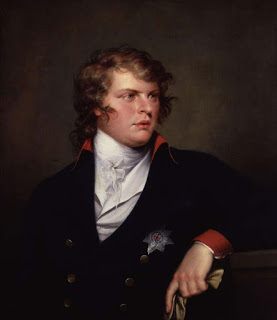 Prince Augustus Frederick, Duke of Sussex
Loretta reports:
Prince Augustus Frederick, Duke of Sussex
Loretta reports:As everybody who follows royal doings now knows, the Queen has made Prince Harry the Duke of Sussex . This may puzzle some people who watched the video I posted not long ago, The Last of the Dukes . There we were told that we could not look forward to any new dukes.
However, a royal duke is a different article. He’s a member of the royal family who happens to be a prince, upon whom the sovereign has bestowed the title—as the Queen did in the cases of her sons as well as her grandsons. For further details, such as how long the title remains royal and where these royal dukes stand in precedence, I recommend this Wikipedia article . It offers a fairly easy-to-understand and, I think, fascinatingly nerdy account.
As a nerdy history girl, what I found interesting, was this particular choice of title. The last Duke of Sussex was a gentleman I wrote about last October , where I quoted a description of him as “the most consistently Liberal-minded person of the first half of the nineteenth century.” You can read more about him here at the Georgian Era blog .
 Prince Harry, Duke of Sussex
Prince Harry, Duke of Sussex
Of course I have no idea why the Queen chose the Sussex title for Prince Charles’s second son. However, in light of the choice of bride; the wedding celebration, including the clergy and guests; and the causes the gentleman has espoused, I like to think of it as a nod to her progressive ancestor as well as to the new duke and the future we hope for him (excluding the problematic relationships with women, of course).
Images: Prince Augustus Frederick, Duke of Sussex , by Guy Head, National Portrait Gallery NPG 648.
Prince Harry, Duke of Sussex, speaks during the opening ceremonies of the 2017 Invictus Games (edited), Creative Commons License, Author DoD News .
Clicking on the image will enlarge it. Clicking on the caption will take you to the source, where you can learn more and enlarge images as needed.
Published on May 23, 2018 21:30
May 21, 2018
What the Groom Wore: Prince Harry's Frock Coat
 Susan reporting,
Susan reporting,Like millions of other people willing to get up extra early on a Saturday morning, Loretta and I have been enthralled by this week's royal wedding of Ms. Meghan Markle and His Royal Highness Prince Henry of Wales. One thing that fascinated us the most was the dashing dark uniform that Prince Harry chose to wear to his wedding.
The long coat is described as a frock coat, and is particular to the Household Cavalry, which is formed of two regiments - The Life Guards and The Blues and Royals. (The style of the knee-length frock coat evolved from men's 19thc fashion, with additional inspiration from the Ottomans.) It was worn in "Undress" instead of Full Dress, most likely because the choice of Windsor Castle made the wedding a less formal affair. This was not a state occasion, nor will Harry be king. Harry's brother William, Duke of Cambridge, wore the same uniform for the ceremony, and miniature adaptations were created for the bride's page boys.
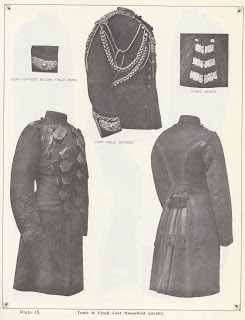
Both brothers' uniforms were created by traditional military tailors Dege & Skinner on Savile Row, and were said to have taken over 100 hours to stitch and tailor by hand. Details are everything, even in a seemingly monochrome coat: the intricate interwoven braid on the sleeves (which was barely visible on television) took a single skilled craftsman over a week to create. The frock coat's primary fabric is doeskin, a fine satin-weave woolen cloth, and the lining is silk.
The frock coat is closed with hidden hooks instead of buttons. Many Americans were perplexed by what they saw as "ribbon bows" on the front of the jacket. This is instead a braiding made of black mohair, and is unique to the Household Cavalry and the Life Guards. While the braid loops could in theory fasten to the olivets (the toggle-style buttons on the far sides of the chest), they are traditionally worn unbuttoned, and are purely decorative.
The illustrations, right, are from Dress Regulations for Officers of the Army 1900, and show the approved pattern of the Frock Coat of the Household Cavalry. The illustrations show the details of the frock coat that weren't visible in the wedding broadcast (click on the image to enlarge.)

While the very dark navy color made for a striking contrast to Meghan's bright white gown, it's not simply a style choice, but a uniform that Harry has earned the right to wear. He served as a Captain in The Blues and Royals, and after retiring from active duty in 2015, he received the honorary military title of Major from the Queen, as signified by the crown on his shoulder. According to Kensington Palace, he also requested and received express permission from the Queen to wear the uniform on his wedding day.
Rumor has it that the Queen also bestowed a certain leniency to Harry in another way. Officers in the Army are required to be clean-shaven, and there was speculation that Harry would shave away his now-familiar beard for the wedding. The fact that he didn't suggests that the Queen gave him special permission to keep the whiskers.
One more detail: did you notice that both brothers wore silver spurs as members of the cavalry?
Many thanks to Patrick Baty for his always-excellent assistance with this blog post.
Upper left: Neil Hall/Pool/Reuters
Lower left: PA/UK Images
Published on May 21, 2018 21:00
May 20, 2018
From the Archives: Queen Victoria's Wedding Drew a Crowd, Too.
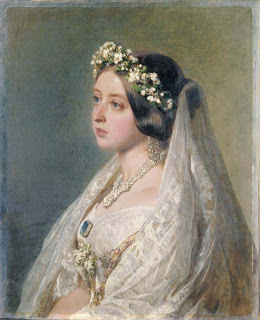 Queen Victoria in her wedding dress painted 1847
Loretta reports:
Queen Victoria in her wedding dress painted 1847
Loretta reports:The recent marriage of the Duke and Duchess of Sussex sent me back into the archives to look at the excitement that accompanied Queen Victoria's wedding on 10 February 1840, in rotten weather. Researching for the short story I wrote at the time, I learned, among other things , that royal wedding frenzy is nothing new.
~~~
All ranks of the people in the metropolis, and for many miles around, began to rise before the appearance of the dawn, some to prepare to take their stations in the progress of the approaching great ceremony; but the great multitude, of course, thinking that their exertions would be well repaid, if they could get only a moment's glimpse of the Queen and her husband, or even a glance at the procession going and returning. Notwithstanding the discouraging weather, the streets were crowded at an early hour with thousands, coming from every point of the compass, and making the best of their way, with emulous and unceremonious haste, to St. James's Park, as one common centre. The concourse of females was prodigious. It seemed as if every one of her Majesty's sex, from the infant in arms to the decrepit matron, now far advanced in second childhood, had made a vow not to stay at home. Women, who could not see their way without spectacles, nor walk it without crutches, were to be seen anxiously struggling for precedence at every point of the park, whence a glance at the Queen and Prince might be obtained; and, having once obtained an eligible spot, they held fast by it, heedless of the too frequent probabilities of being crushed or trodden to death. The trees, the lamp-posts, and the spikes of the railings, were contended for with as much eagerness as if the summit of every one's ambition was at the top of one or other of these elevations; and the wonder was, how many, who had climbed up to certain dangerous eminences, could ever get down in safety again. However, these adventurous folks justly thought, that that question was their own " look out," and no one's else's. About ten o'clock St. James's Park was completely filled with a vast, miscellaneous, curious multitude, not a tithe of whom, unfortunately, could see even the carriage of the Queen when it did at length pass.
—The Mirror of literature, amusement, and instruction, Volume 35, 1840Marriage of Queen Victoria
Illustrations: Franz Xaver Winterhalter (1805–1873) Queen Victoria , in her wedding dress and veil from 1840, painted in 1847 as an anniversary gift for her husband, Prince Albert.
Source/Photographer. Original painting owned by the Royal Collection. Source of photograph unknown.
The Marriage of Queen Victoria , 10 February 1840, painted by George Hayter 1840-1842. Royal Collection RCIN 407165 , via Wikipedia.
Clicking on the image will enlarge it. Clicking on the caption will take you to the source, where you can learn more and enlarge images as needed.
Published on May 20, 2018 21:30
May 19, 2018
Breakfast Links: Week of May 14, 2018
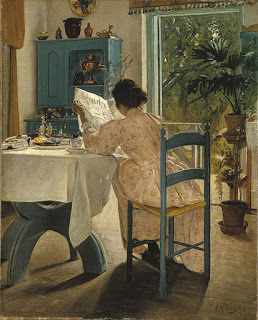 Breakfast Links are served! Our weekly round-up of fav links to other web sites, articles, blogs, and images via Twitter.
Breakfast Links are served! Our weekly round-up of fav links to other web sites, articles, blogs, and images via Twitter.• The art and mystery of 18thc mantua-makers .
• The poet John Keats , and cats.
• Whitewashing ancient statues .
• The fast and the feminine: women, cars, and advertising.
• Eighteenth century ships unearthed in Alexandria, VA offer glimpse of colonial era.
• Image: A rare and possibly unique 17thc document stating that a Dorset woman, Joan Guppy, is not a witch .
• Isaac Henry Robert Mott , piano-forte maker in Victorian London.
• When literary classics are packaged as pulp fiction.
• The Bohemian heiress who shattered 19thc taboos.
• A trove of " letter locking ," or vintage strategies to deter snoops.
• The curious history of mommy-and-me fashion.
• "The scourge of evil": the persecution of witches at Edinburgh Castle.
• The rare, surviving sento, or bathhouse inside Seattle's Panama Hotel, an important relic of Japanese-American history.
• Ann Roberts , foster mother to a king - at a terrible sacrifice, 1910.
• National Geographic's digital archive has every map ever published in the magazine since 1888.
• The legend of Pope Joan , who reputedly gave birth during a papal procession.
• When King George VI broke the lock to the New Bodleian library.
• This trunk filled with unread letters from the 17thc is an historian's dream.
Hungry for more? Follow us on Twitter @2nerdyhistgirls for fresh updates daily.
Above: At Breakfast by Laurits Andersen Ring. Private collection.
Published on May 19, 2018 14:00
May 17, 2018
Friday Video: Fashion Show of 1951
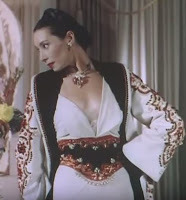 Loretta reports:
Loretta reports:Those of us familiar with 1950s fashion will recognize at least some of the designers featured in this short film. If you like mid-century style , you might swoon over several ensembles—or maybe all of them. However, the audience is interesting, too. Those of us who follow such things are used to seeing the various Fashion Week shows with a large audience lined up on either side of a long runway. This one, at the Savoy Hotel, London, feels very exclusive, very much a private showing. It’s sedate, with no attempt at being inventive about the presentation or the venue. You may also notice how differently from today's models these women carry themselves: they have a different way of walking and they actually smile a little.
She Walks In Beauty (1951) British Pathé
Readers who receive our blog via email might see a rectangle, square, or nothing where the video ought to be. To watch the video, please click on the title to this post or the video title.
Image is a still from the video.
Published on May 17, 2018 21:30
May 16, 2018
From the Archives: Jane Austen's Surprising Aunt Philadelphia
 Susan reporting,
Susan reporting,With my manuscript deadline drawing ever-closer, here's another favorite post from the archives about a woman who could certainly inspire a book of her own.
In 18thc Britain, it wasn't only younger sons who went out to India in search of fortune and adventure. English women also made the arduous journey in the hopes of finding fortune, adventure, and, most importantly, husbands in a male-dominated land where the odds would be much in their favor.
One of these adventuresome women was Philadelphia Austen Hancock, who in her later years became a favorite aunt to novelist Jane Austen. As a child, however, Philadelphia was no one's favorite. Born in 1730, she soon lost her mother in 1733, and her father in 1737. Her stepmother had no interest in raising either Philadelphia or her younger brother and sister, and as was sadly common at the time, the three young siblings were separated and sent to live with other relatives.
While the two younger children were sent to Austen family members, Philadelphia was given to members of her mother's family, the Hampsons. The Hampsons had both money and position - Philadelphia's uncle was a baronet - but they seemed to have shared little of it with the inconvenient little girl. While Philadelphia's brother George was sent to Oxford to become a clergyman, Philadelphia was apprenticed at fifteen to a London milliner named Hester Cole. No doubt the Hampsons considered their familial obligations done.
Some modern Austen-fans choose to interpret Philadelphia's occupation as a euphemism for prostitution, jumping to the conclusion that because many milliners (and seamstresses, and mantua-makers, and parlor-maids, and just about every other trade that a young woman might attempt in 18thc. London) were so underpaid that they turned to prostitution to support themselves. The fact that Mrs. Cole's shop was in Covent Garden also makes it tempting to speculate about Philadelphia's real trade. But however disinterested the Hampsons may have been in her, it seems unlikely they'd send her to a bawdy house, nor is there any historical proof of Philadelphia earning her living in any less-than-honorable way.
Whatever the case, Philadelphia must not have found millinery to her taste, because at twenty she sailed for India, her passage paid by a relative. No one knows if she went boldly through her own choice, or was perhaps sent away by the Hampsons (another hint of scandal?) Either way, it must not have been an easy decision, and it's hard to imagine a young woman making such a desperate journey alone, and without any real prospects or friends waiting for her in a very foreign land. Without a dowry, her face really would have been her only fortune.
But Philadelphia's gamble paid off. After a short time in India, she did marry, quite respectably, to Tysoe Saul Hancock, who was a surgeon with the East India Company. They had one daughter, Eliza. Again the centuries-old whispers appear, hinting that Eliza's real father was her wealthy godfather Warren Hastings, the future Governor General of India. Again, too, there is no real proof to substantiate the rumors, but Philadelphia had chosen her daughter's godfather - or her own lover - well: Hastings provided Eliza with a substantial legacy of £10,000.
In any event, Philadelphia and her daughter returned to London, while Hancock continued to toil in India. Eliza was raised as a lady, with a full compliment of lessons in dancing, French, and the harp, and all the advantages that Philadelphia hadn't had for herself. When Dr. Hancock died, the two women found London too expensive for the fashionable life they wished to live, and they went instead to Paris, where they were quickly swept up into the gay life of the French society in the last days before the Revolution. Wanting the security for Eliza that she couldn't provide herself, Philadelphia urged her towards a marriage with a French count, who died on the guillotine. (Eliza's second marriage, to her cousin Henry Austen, was both longer and happier.) While Philadelphia's decisions might not always seem today to have been the wisest for her or her daughter, she made them as a woman of her time, with limited options and resources.
Regardless of the shadows in her past, Phila (as she was known in the family) was welcomed at the home of her brother George, now a clergyman, and she was with George's wife when their daughter Jane was born. It's easy to imagine why Aunt Phila became Jane's favorite aunt: not only was she a trusted member of the family, but she also carried with her that hint of mystery and scandal, along with the exoticism of India and the sophistication of Paris - all in short supply in the home of a country clergyman.
When I look at the little miniature of Philadelphia shown here, I see only an elegantly attractive lady, with a fashionable hairstyle and a genteel smile. That little half-smile only makes me long to know the truth about her personal history, and to fill in all those scandalous gaps that time (and perhaps the well-meaning and more respectable George) have glossed over. Ahh, Jane, if only you'd written your aunt's story!
Top: Miniature portrait ring of Philadelphia Austen Hancock, by John Smart, c1768. Private collection. Photograph copyright Rowan & Rowan.
Published on May 16, 2018 21:00
May 14, 2018
Boswell's London Romps & Repentance
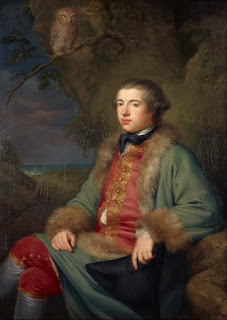 James Boswell 1765 by George Willison
Loretta reports:
James Boswell 1765 by George Willison
Loretta reports:James Boswell, famed for his biography of Samuel Johnson, was a piece of work. I’ve posted from his London Journals before . Please read and form your own conclusions.
Here's another bit from Boswell’s London Journal 1762-1763 , (my Yale University first edition of 1950). I love that he skipped the countess’s party because his hair wasn’t just right, but it didn’t stop him from heading for the streets, and “fresh, young” girls.
TUESDAY 17 MAY [1763]
I should have been at Lady Northumberland’s rout tonight, but my barber fell sick; so I sallied to the streets, and just at the bottom of our own, I picked up a fresh, agreeable young girl called Alice Gibbs. We went down a lane to a snug place, and I took out my armour,* but she begged that I might not put it on, as the sport was much pleasanter without it, and as she was quite safe. I was so rash as to trust her, and had a very agreeable congress.
WEDNESDAY 18 MAY [1763]
Much concern was I in from the apprehension of being again reduced to misery**, and in so silly a way too ...
THURSDAY 19 MAY [1763]
... I then sallied forth to the Piazzas in rich flow of animal spirits and burning with fierce desire. I met two very pretty little girls who asked me to take them with me. “My dear girls,” said I, “I am a poor fellow. I can give you no money. But if you choose to have a glass of wine and my company and let us be gay and obliging to each other without money, I am your man.” They agreed with great good humor. So back to the Shakespeare I went. “Waiter,” said I, “I have got here a couple of human beings; I don’t know how they’ll do.” “I’ll look, your Honour,” cried he, and with inimitable effrontery stared them in the face and then cried, “They’ll do very well.” “What,” said I, “are they good fellow-creatures? Bring them up, then.” We were shown into a good room and had a bottle of sherry before us in a minute. I surveyed my seraglio and found them both good subjects for amorous play. I toyed with them and drank about and sung Youth’s the Season, and thought myself Captain Macheath,[9] and then I solaced my existence with them, one after the other, according to their seniority. I was quite raised, as the phrase is: thought I was in a London tavern, the Shakespeare’s Head, enjoying high debauchery after my sober winter.[1] I parted with my ladies politely and came home in a glow of spirits.A Sketch from Nature (Carey, after Rowlandson) 1784
FRIDAY 3 JUNE [1763]
…I am always resolving to study propriety of conduct. But I never persist with any steadiness. I hope, however, to attain it. I shall perhaps go abroad a year or two, which may confirm me in proper habits. In the mean time let me strive to do my best.
[9] “Youth’s the season made for joys” is a song and chorus in The Beggar’s Opera. Macheath is in a tavern near Newgate, surrounded by ladies of the town.
[1] "High debauchery” is debauchery with genteel ceremonial; “low debauchery” is debauchery without.
*armour = condom
** another bout of venereal disease
Images: George Willison, James Boswell , 1765, painting in the National Galleries Scotland. William Paulet Carey, after Thomas Rowlandson, A Sketch from Nature , 1784, Metropolitan Museum of Art.
Clicking on the image will enlarge it. Clicking on the caption will take you to the source, where you can learn more and enlarge images as needed.
Published on May 14, 2018 21:30
May 13, 2018
Women and the Continental Army at Valley Forge, 1777-78
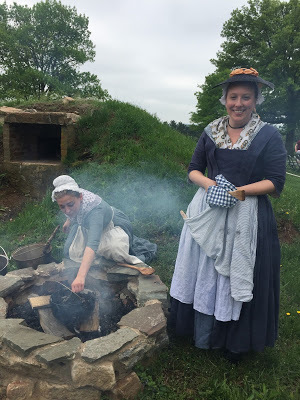 Susan reporting,
Susan reporting,I'm fortunate to live near Valley Forge National Historical Park , which is not only the site of the 1777-78 winter encampment of the Continental Army during the American Revolution, but also a beautiful 3,500 acre park that includes a rivers, streams, forests, and tall-grass meadows.
On Saturday, I visited the park for the history, and a special program devoted to telling the stories of the approximately 400 women (along with about 10,000 soldiers and 2,000 support staff) who were part of the encampment.
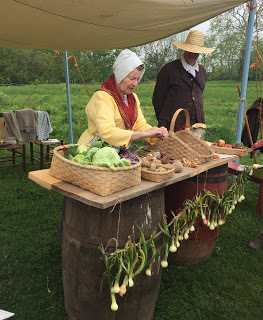
Too often the role of women in connection to the 18thc army is overlooked, ignored, or reduced to mean-spirited camp-follower jokes. In reality, women were an important part of the army's day-to-day life, especially during the months-long winter encampments. Women (and children) who followed the army were paid to wash the army's laundry, sew and mend garments, cook food and bake bread, and tend the sick and wounded. The majority of these women were wives and other family members of the soldiers, who ate and slept as families with their husbands' messes. They also remained connected to the army during the summer campaign season, following at a distance from the army on foot behind the baggage wagons. These were strong women, in every sense of the word.
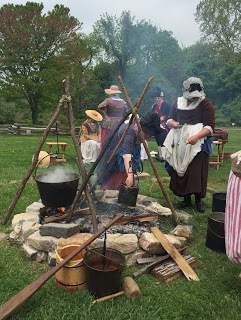
At the other end of the social scale, the wives of officers - including Martha Washington, the wife of the army's Commander-in-Chief George Washington - often left their homes during the war's "off season" and traveled to join their husbands at the winter encampment. Their primary role was undeniably less arduous, but also important. In addition to providing an air of genteel civility for their husbands and the other officers, these ladies helped entertain influential foreign dignitaries visiting the camp as well as members of Congress who came from Philadelphia to review the troops and conditions. In this capacity, they were often unofficial lobbyists who helped promote the army's needs and concerns. They also sewed, knitted, and mended for the soldiers - although, as officers' wives, they weren't paid for their labors.
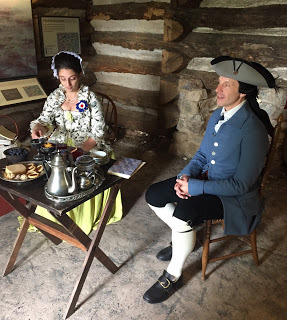
Local women also participated in the market area near the encampment. Opened by Gen. Washington's proclamation in February 1778, the market helped supply fresh provisions to his army by permitting the inhabitants of local farms to sell their goods directly to soldiers. Strictly regulated, the market was a beneficial arrangement for both parties. Not only were the soldiers able to obtain fresh food at a fixed, fair price, but the farmers in turn were able to preserve their crops from foraging soldiers. Although small in scale - the wares of the market vendors would vary from week to week depending on what was available from farms - these local women provided fresh food to augment the soldiers' diets. The market was successful for another reason as well: any food sold to the Continental encampment was food that would not end up in the hands (and mouths) of the British army occupying nearby Philadelphia.
The program at the park showcased many of these women. There were farm women selling the first onions and cabbages of the season, laundresses washing linens, seamstresses stitching shirts, a weaver weaving on a portable tape loom, spies ready to explain secrets and codes, bakers baking bread in a hillside bake oven, and cooks cooking a sausage, onion, and apple stew over an over fire which smelled mighty tasty indeed. There was even an experienced medical woman with a fine display of lancets and scarifiers (I must have missed the leeches) who would have been happy to bleed you to relieve your foul humors.
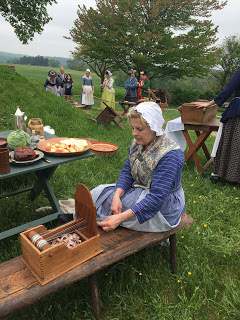
And in one of the cabins, General Nathanael Greene's wife Catharine Littlefield Greene was charming James Lovell, the visiting Congressman from Massachusetts, with tea, tarts, and 18thc jests from a popular magazine of the time.
Hosted by the Park and their "Mom's Army" programming, Saturday's immersive event was largely the creation of two related reenactment groups: Colonel Ogden's First New Jersey Regiment , and the Continental Line (CL) Laundry and Women's Activities Club , led by organizer Samantha Vogeley.
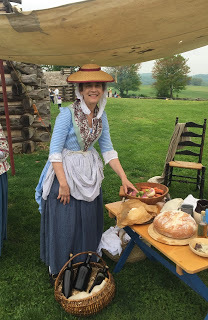
The members of these groups were engaging and incredibly knowledgeable, and generous with that knowledge, and I can't thank them enough for putting up with all my questions. It was also an opportunity to meet in person fellow history-fans that I've known only through social media.
I can't say exactly where or when all this new 18thc knowledge will be put to use, but I can pretty much guarantee it will turn up someday in a book. How can it not, when the research was this much fun?
One final note in light of some of our recent discussions here at TNHG: Every woman participating in the event was wearing period-correct clothing, including boned stays (18thc corsets.) I'm happy to report that despite the many heavy iron kettles hoisted over fires and water-filled oak buckets lifted, no one fainted.
All photos ©2018 Susan Holloway Scott.
There are many more photographs from the event on Facebook, taken by Molly Pictures Studio. The link is here.
Published on May 13, 2018 18:12
May 12, 2018
Breakfast Links: Week of May 7, 2018
 Breakfast Links are served! Our weekly round-up of fav links to other web sites, articles, blogs, and images via Twitter.
Breakfast Links are served! Our weekly round-up of fav links to other web sites, articles, blogs, and images via Twitter.• A packet of seeds and a sheet of music called "Romances d'Estelle": part of the prize included in a Dutch ship captured by the British in 1803.
• Anne of Green Gables goes to war.
• A hundred-year-old handmade American flag flies home...to Scotland.
• Analyzing the fashion details in an 1830s portrait of a Susan Brown Moody .
• The trashy, expensive, contradictory reputation of leopard print .
• Image: A 1789 cyanometer that measured the blueness of the sky.
• How to suppress the writing of women like the Brontes : "She only wrote one good book."
• Wojtek , the bear who went to war, and linked together the heritage of Scotland and Poland.
• The Household Book of Richard Beauchamp, Earl of Warwick, can tell you who came to dinner on Sunday, May 13, 1431.
• Image: A Hayden concert ticket from 1792, signed by the composer.
• Elizabeth Arden thoughtfully (!) provided these hints in 1943 for how women in the military could adapt their hairstyles to their uniform caps.
• Shakespeare and marriage , in his plays and in his own life.
• Repurposed stone first shaped by Roman builders discovered in a medieval Saxon vault .
• Traces of a famously lost ninth-century Bible turn up in a 1474 printed book.
• The torrid love letters of famous authors.
• Image: Rediscovered in a London church, an original Waterloo Fund collection box for aid to the wounded and families of the fallen at Waterloo.
• Discovering the history of the Ram Jam Inn , and its links to notorious 18thc highwayman Dick Turpin.
• An interactive map with merpeople sightings, 1610-1784.
• Eveline, Elsie, Agnes, and Joan: May Queens through time.
Hungry for more? Follow us on Twitter @2nerdyhistgirls for fresh updates daily.
Above: At Breakfast by Laurits Andersen Ring. Private collection.
Published on May 12, 2018 14:00



